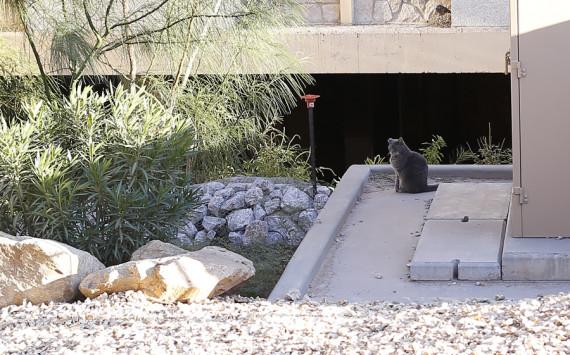As UTEP continues to transform, one thing has stayed constant in the untouched shadows—the feral cat population on campus.
Since its inception in 2000, the Trap-Neuter-Return program on campus has operated on-and-off throughout the years.
Since December 2012, the TNR program, operated by the Environmental Health and Safety department, has started up again due to a slight increase in the cat population.
A new micro-chipping initiative began this year along with regular procedures, where volunteers set traps to capture the cats, spay or neuter them, vaccinate them for rabies and return them back to campus.
“We started seeing kittens again from other places we don’t know,” said Robert Moss, assistant vice president for EH&S. “We have trapped 46 cats in total since. Forty were spayed or neutered and returned to campus, five were adopted and one was put down because he was very sick.”
The goal of the TNR program is to provide a humane solution to the cat population rather than using the catch-kill technique, where cats were trapped and immediately taken to animal services to be euthanized—a technique used in previous years in El Paso communities.
“We do the humane thing,” Moss said. “We have recently associated with El Paso Animal Services because they were willing to expand their program to us.”
Moss said El Paso Animal Services is called as a last resort if the TNR team cannot care for the cats.
“They’re desperate animals that are left alone and because they’re alone, they get hurt,” Moss said. “Especially now with construction, they are spooked.”
Moss and the rest of his staff create spreadsheets of the cats that have already been captured and spayed or neutered. Pictures are taken of each cat and a note is made on where that cat was found. Once the procedure is completed, they are released in the same area.
Anahi Marquez, senior cellular and molecular biochemistry major, is not a fan of cats, but she said she isn’t bothered by the ones that cross her path on campus.
“I feel bad for any people that are allergic to them and for the cats themselves, but it would be nice if they found a home to be taken care of,” Marquez said. “I feel that the construction could potentially harm them. I mean we are all a little disturbed by the construction and any shelter they had could have been destroyed or they could get hurt by the machinery.”
Along with the TNR program at UTEP, there are several other organizations around the city that utilize this technique in order to reduce the number of free-roaming, or feral cats, in the El Paso community.
Sun City Cats was created last year and has been endorsed by the El Paso Veterinarian Association, The Animal Shelter Advisory Committee and Animal Services. The SCC follows strict guidelines in order to deliver humane solutions.
Feral cats are unadoptable and when they are taken to animal shelters, 99 percent of them will be euthanized within three days. The procedure for euthanizing an animal comes directly from tax-payer dollars.
Kurt Fenstermacher, deputy director for the El Paso Environmental Services Department, is in partnership with Sun City Cats and is currently applying for a second grant under PetSmart Charities.
“They offered us the opportunity to go to the 79907 zip code to help 1,000 cats. So the groups went out there and the cats were spayed and neutered and micro-chipped, which is different for El Paso,” Fenstermacher said. “The grant with PetSmart Charities is renewable, so they will give us another area code to help another 1,000 cats along with some money.”
The first grant was received in October 2012 with $50,000 going toward the spay and neuter program.
“That’s a lot more than we have ever spent on a spay and neuter program. A non-profit organization is granting us this money, and in turn, we do the surgeries, the volunteers take the cats back, and they don’t get picked up by the officers,” Fenstermacher said. “Hopefully, we’ll see a reduction in the cat-related nuisance calls and the number of free-roaming cats with the TNR program.”
It may take three to five years for the effects to become visible, but until then, SCC and other animal services will continue to go to specific areas with a high number of impounds reported and continue the TNR techniques there.
Because people are being irresponsible by dropping off cats and leaving them on campus, whether it’s students or people from the city, it keeps the problem from getting better, Moss said.
“We have other problems with feral animals when food is left out. There are people that aren’t being responsible for their animals. I wish they would, but animals are still roaming the campus,” Moss said. “We don’t encourage people to leave animals here. It’s a rough life to be a free-range animal within a city.”
Students interested in helping or volunterring for the feral cat program or the spray/neuter program can visit suncitycats.org.
Lorain Watters may be reached at [email protected].
Campus cats find support through community programs
Categories:
aaron montes / The Prospector
Feral cats are unadoptable and when they are taken to animal shelters, 99 percent of them will be euthanized within three days..
3
0
About the Contributors

Lorain Watters, Editor-in-chief Editor
Lorain Watters is a senior psychology and multimedia journalism major. She is currently the managing editor at The Prospector, previously holding the position of entertainment editor.
Along with the newspaper and classes, Lorain is also a part of the National Society of Collegiate Scholars honors organization on campus.
In her spare time, she enjoys reading at coffeeshops, discovering new music and driving. Lorain strives to work for the New York Times or the Huffington Post in the future.

Aaron Montes, Staff Photographer
Aaron Montes is a junior multimedia journalism student at the University of Texas at El Paso.
He graduated from Burges High School in 2010, where he was the head photographer for three years with his yearbook organization, Hoofbeats, the newspaper, Stampede and a literary magazine, Pegasus.
With The Prospector, Aaron has been a photographer, the photo editor and multimedia editor.
His major contributions to the publication have come through coverage of the ASARCO and City Hall demolitions and with the bomb threat on campus March 28th.
He plans on doing investigative reporting in political and economical issues in El Paso and nationally. He strives to become part of the Associated Press.
More to Discover







Jessica • Dec 5, 2013 at 11:02 PM
1)Yes, they are an invasive man-made species who are threatening El Paso’s wildlife. However, there is no such thing as a HUMANELY enough practice to euthanize life. Drowning? Shot? Are you kidding me?
We are trapping them, spaying/neutering them, vaccinating them and releasing them to campus because we don’t believe in ending life. Period.
2)This is a good method because cats will live their entire life on campus eating, yes, many native species but also pigeons who are also an invasive species. And hopefully they will die of “old age” . At the end there will not be more cats on campus unless more people keep bringing cats to UTEP. That is what you need to be worrying about, people bringing their cats to UTEP. Why don’t you act against people doing this instead on thinking about inhumane euthanizing methods? Cats are just another species victim of humanity.
3)Texas is a very wide state where I’m sure native species can live and not be in the border of extinction caused by temporal cats living at UTEP.
4) STOP thinking about taxes and money. START thinking about the most humane thing you can do in your life and EUTHANIZE yourself.
Woodsman • Oct 23, 2013 at 12:41 AM
Here’s how these delusional, self-serving, and uneducated TNR-advocates are destroying all life on the planet.
The TNR CON-GAME
FACT: Trap & Kill failed because cats cannot be trapped faster than they exponentially breed out of control.
FACT: Trap, Neuter, & Re-Abandon (TNR) is an even bigger abject failure because these man-made ecological disasters cannot be trapped faster than they exponentially breed out of control, and they also continue to cruelly annihilate all native wildlife (from the smallest of prey up to the top predators that are starved to death), and the cats continue to spread many deadly diseases that they carry today — FOR WHICH THERE ARE NO VACCINES AGAINST THEM. Many of which are even listed as bioterrorism agents. (Such as Tularemia and The Plague — Yes, people have already died from cat-transmitted plague in the USA. No fleas nor rats even required. The cats themselves carry and transmit the plague all on their own.)
FACT: THERE IS ABSOLUTELY _NOTHING_ HUMANE ABOUT TNR. Nearly every last TNR’ed cat dies an inhumane death by road-kill, from cat and animal attacks, environmental poisons, starvation, dehydration, freezing to death, infections, parasites, etc. And if very very lucky humanely shot to death or re-trapped and drowned (the two most common methods employed on all farms and ranches to protect their gestating livestock’s offspring and valuable native wildlife dying from cats’ Toxoplasmosis parasites). This doesn’t begin to count the thousands of defenseless native animals that cats skin alive and disembowel alive for their daily and hourly play-toys. And pitting cat against cat to fight-to-the-death for territory is ABSOLUTELY NO DIFFERENT than those who run criminal dog-fight rings to see who is the winner. They spend YEARS in jail. The only difference in destroying cats immediately and humanely instead of trapping, sterilizing, then releasing them to an inhumane death; is that money isn’t going into an HSUS or SPCA board-member’s pocket, veterinarian’s pocket, cat-food company CEO’s pocket, or a drug-company CEO’s pocket. And that’s the ONLY difference!
FACT: These manipulative, deceptive, and deceitful TNR proponents are now clipping cats ears ONLY. WITHOUT vaccinations nor sterilizing them. They do this to save money and protect their outdoor hoarded cat colonies from being trapped and euthanized by the state because the clipped-ear shows officials that they have been sterilized and vaccinated. Why pay $140 for each cat and all that time when just a trap and a simple snip of scissors on each one can also protect their hoarded cats from being destroyed? (I have absolute proof of this.)
FACT: Cats are a man-made (through selective breeding) invasive species. And as such, are no less of a man-made environmental disaster than any other caused by man. Cats are even worse than an oil-spill of continent-sized proportions. They not only kill off rare and endangered marine-mammals along all coastlines from run-off carrying cats’ Toxoplasma gondii parasites, they destroy the complete food-chain in every ecosystem where cats are found. From smallest of prey gutted and skinned alive for cats’ tortured play-toys, up to the top predators that are starved to death from cats destroying their ONLY food sources. (Precisely what cats caused on my own lands not long ago.)
FACT: Hunted To Extinction (or in this case, extirpation of all outdoor cats) is the ONLY method that is faster than a species like cats can exponentially out-breed and out-adapt to. Especially a man-made invasive species like these cats that can breed 2X-4X’s faster than any naturally occurring cat-species.
FACT: In _FOURTEEN_YEARS_ Alley Cat ALL-LIES branch of NYC have only reduced feral cats in their own city by 0.08% to 0.024% (as the months go on that percentage becomes more insignificant), allowing more than 99.92% to 99.976% to exponentially breed out of control. Here’s how Alley-Cat-ALL-LIES’ deceptive math works: If you TNR 4 cats and 3 get flattened by cars this translates to 75% fewer feral-cats everywhere. Alley Cat ALL-LIES can’t even reduce cats in their own city, yet they promote it as a worldwide solution. Then even bigger fools fall for it and promote it.
FACT: When researching over 100 of the most “successful” TNR programs worldwide, JUST ONE trapped more than 0.4%. Oregon’s 50,000 TNR’ed cats (the highest rate I found) is 4.9% of all ferals in their state. Yet, by applying population growth calculus on the unsterilized 95.1% they will have trapped only 0.35% of all cats in their state sometime this year. Less than 0.4% is a far cry from the required 75%-85% to be the least bit effective.
FACT: Their mythical “vacuum effect” is a 100% LIE. A study done by the Texas A&M University proved that any perceived “vacuum” is just the simple case that CATS ATTRACT CATS. Get rid of them all and there’s no cats there to attract more. I proved this myself by shooting and burying hundreds of them on my own lands. ZERO cats replaced them FOR NEARLY FOUR YEARS NOW. If you want more cats, keep even one of them around, more will find you. That university study also found that sterilized cats very poorly defend any territory. Non-sterilized cats, being more aggressive, take over the sterilized cats’ resources (shelter & food if any). If there is any kind of “vacuum effect” at all, it is that sterilizing cats cause non-sterilized cats to restore the reproductive void.
FACT: During all this investigation I have discovered something that is unfaltering without fail. Something that you can bet your very life on and win every last time. That being — IF A TNR CAT-HOARDER IS TALKING THEN THEY ARE LYING. 100% guaranteed!
Woodsman • Oct 23, 2013 at 12:11 AM
Any establishment of “higher” education; whose administrators, faculty, science departments, and students are so uneducated and foolish as to allow and promote an infestation of human-engineered invasive species predators; capable of transmitting many deadly zoonotic diseases to students and staff on their own campus; is most certainly worthy of being passed-up in order to find a place with people having education levels above that of 3rd-grade elementary-school.
I’d never want to attend a campus like that. Give people like that MY money? You must be joking. Encouraging and assisting a man-made invasive species to destroy all our valuable native wildlife? This doesn’t say much for the intellect that is in charge of and roaming those halls. A clearly visible alert in the sub-standard IQ levels permeating all levels of that institution.
Unless, of course, this is like where some colleges keep TNR (trap, neuter, re-abandon) cats as a ready supply of dissection specimens for biology finals and for other experiments. Then the TNR “death by attrition” excuse does come in handy to cut costs on some campuses. “They died of ‘TNR attrition’,” makes it so easy explain-away why so many disappeared and nobody can find the carcasses. It seems to be a popular trend of cost-cutting on some campuses of late. The TNR proponents never the wiser (for that, is clearly impossible).